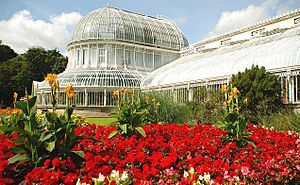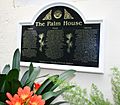Botanic Gardens (Belfast) facts for kids
Quick facts for kids Botanic Gardens Belfast |
|
|---|---|

Palm House and flower bed
|
|
| Type | Botanical |
| Location | Belfast, County Down |
| Area | 28 acres (110,000 m2) |
| Owned by | Belfast City Council |
| Status | Open All Year |
| Collections |
|
| Public transit access | Botanic railway station |
| Website | Botanic Gardens |
Botanic Gardens is a public garden in Belfast, Northern Ireland.
Occupying 28 acres (110,000 m2) of south Belfast, the gardens are popular with office workers, students and tourists. They are located on Stranmillis Road in Queen's Quarter, with Queen's University nearby. The Ulster Museum is located at the main entrance.
History
The gardens opened in 1828 as the private Royal Belfast Botanical Gardens. It continued as a private park for many years, only opening to members of the public on Sundays prior to 1895. Then it became a public park in 1895 when the Belfast Corporation bought the gardens from the Belfast Botanical and Horticultural Society. The Belfast Corporation was the predecessor of Belfast City Council, the present owner.
The Palm House
The gardens' most notable feature is the Palm House conservatory. The foundation stone was laid by the Marquess of Donegall in 1839 and work was completed in 1840. It is one of the earliest examples of a curvilinear cast iron glasshouses in the world. Designed by Charles Lanyon and built by Richard Turner, Belfast's Palm House predates the glasshouses at Kew and the Irish National Botanic Gardens at Glasnevin, both of which Turner went on to build. The Palm House consists of two wings, the cool wing and the tropical wing. Lanyon altered his original plans to increase the height of the latter wing's dome, allowing for much taller plants. In the past these have included an 11 metre tall globe spear lily. The lily, which is native to Australia, finally bloomed in March 2005 after a 23-year wait. The Palm House also features a 400-year-old Xanthorrhoea.
Other features
The gardens contain another glasshouse, the Tropical Ravine House. Built by head gardener Charles McKimm in 1889, it features a unique design. A sunken ravine runs the length of the building, with a balcony at each side for viewing. The most popular attraction is the Dombeya, which flowers every February.
The Palm House and the Tropical Ravine House were symbols of Belfast's growing industrial might and prosperity in the Victorian era and attracted over 10,000 visitors a day. The gardens also feature one of the longest herbaceous borders in the UK and Ireland. There is also a rose garden built in 1932 and various species of tree, including the hornbeam-oak. A statue of Lord Kelvin stands at the Stranmillis Road entrance.
-
Belfast born physicist Lord Kelvin at the entrance to the Botanic gardens
Concerts
Concerts and music festivals are held at the Stranmillis Embankment end of the gardens. From 2002 to 2006 the Tennents ViTal festival was held in the gardens. Performers included Kings of Leon, Franz Ferdinand, The Coral, The Streets and The White Stripes. In 2006 Snow Patrol, The Raconteurs, Editors and Kaiser Chiefs played at the festival.
On 26 August 1997 U2 played their first Belfast concert in over a decade as part of the PopMart Tour. 40,000 fans attended, with thousands more lining the perimeter fence and watching from rooftops on Ridgeway Street. Local band Ash and Howard B were the support acts.
Celine Dion was due to perform in the Botanic Gardens on 29 May 1999 during her Let's Talk About Love World Tour, however the show was cancelled along with her performance in Dublin on 27 May 1999.
Botanic Station
Frequent trains operated by Northern Ireland Railways run to Botanic railway station.
Images for kids
See also
 In Spanish: Jardín botánico de Belfast para niños
In Spanish: Jardín botánico de Belfast para niños











